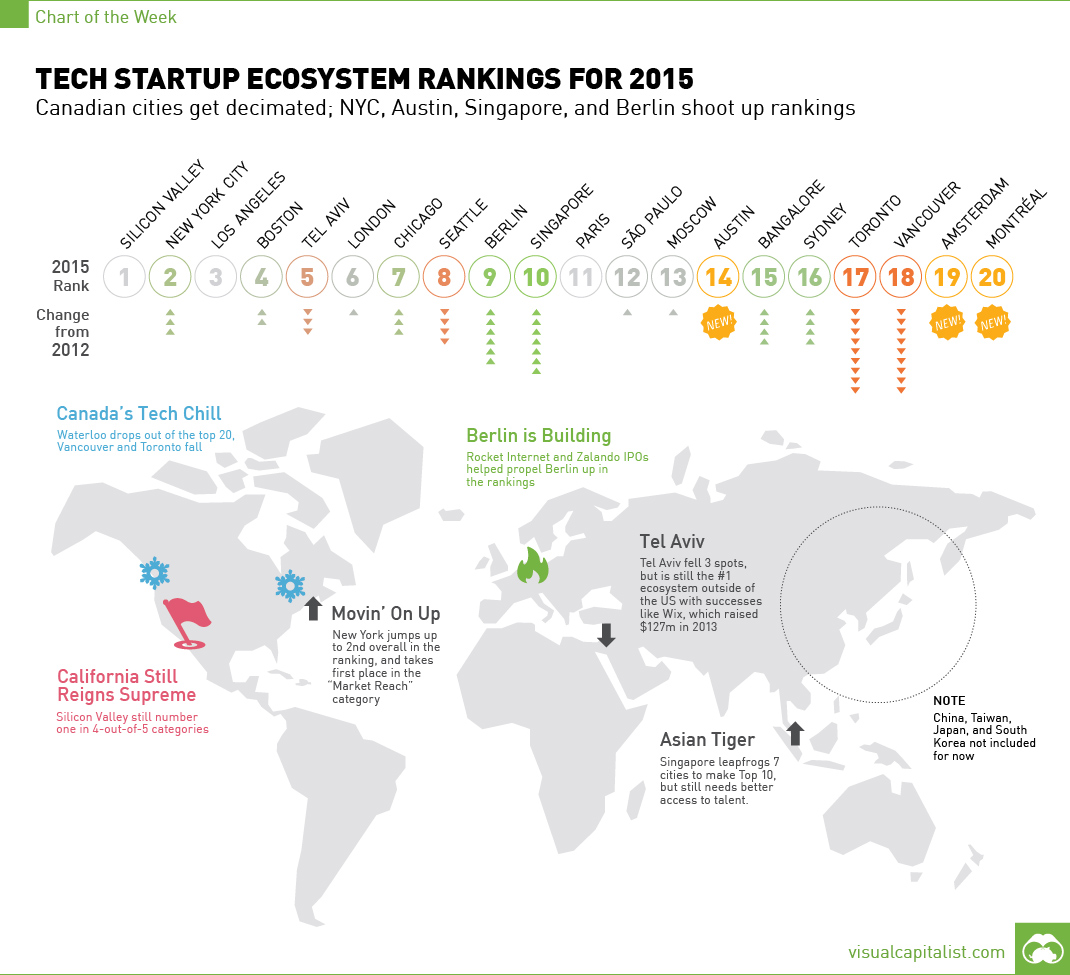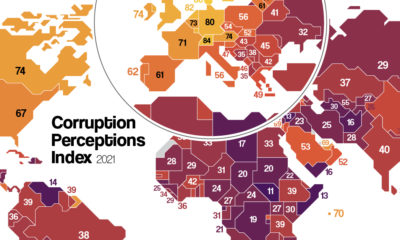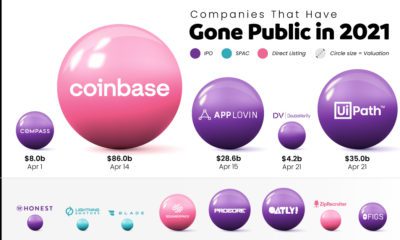Tech Startup Ecosystem Rankings for 2015 [Chart]
Canadian cities get decimated; NYC, Austin, Singapore, and Berlin shoot up startup ecosystem rankings
The Chart of the Week is a weekly Visual Capitalist feature on Fridays.
The Global Startup Ecosystem Ranking 2015 report ranks the top 20 technology startup ecosystems in the world based on Performance, Funding, Market Reach, Talent, and Startup Experience.
Performance is based on the funding and exit valuations of startups headquartered in the ecosystem, and Funding represents the amount of investments by venture capitalists and the time it takes to raise capital. Talent is based on the quality of technical talent, availability, and cost. Market Reach is the local system’s GDP and ease of reaching customers internationally, while Startup Experience is a qualitative measure based on surveying veteran startup mentors and local founders on the success of startups in that particular region.
The report had several significant findings since its last iteration in late 2012. Particular stories that stand out: Canadian cities are dropping drastically, cities outside of North America such as Berlin and Singapore are climbing the rankings, and the United States remains strong with four of the top five ecosystems.
Despite having many companies in the Narwhal Club, home to companies valued at more than $1 billion such as Slack, Hootsuite, and Avigilon, the Canadian market has struggled relative to the rest of the world. Waterloo, home of the once-mighty RIM, has fallen out of the Top 20 altogether. Toronto and Vancouver each dropped nine spots, more than any other ecosystem on the list, claiming the #17 and #18 spots respectively. Vancouver had the third slowest growth out of all cities in the index, and continues to struggle as far as funding goes. Toronto had the fifth slowest growth and also needs to expand growth to venture capital.
In good news for Canada, Montreal debuted on the list, but only at #20.
Slower growth in Canada has been met with exploding markets in Berlin and Singapore. Both of these international centers have had recent success stories that have moved them up the startup ecosystem rankings.
Berlin jumped an impressive six spots to #9 overall and had 20x the average growth of all startup markets. Zalando, Europe’s largest online-only fashion retailer raised $668 million in an IPO to value the company at $6.8 billion overall. Meanwhile, Rocket Internet had the biggest IPO since 2007 in Germany, raising $2 billion.
Singapore moved up seven places, more than any other ecosystem, to round out the Top 10. Growth was relatively average, but the government’s support of the ecosystem and Singapore’s strong financial community helped out its ranking in the Funding category. Garena, a social gaming platform, is valued at $2.5 billion and is one of Singapore’s bright stars.
Lastly, the United States remained on top of the leaderboard with four cities in the Top 5. Silicon Valley remains at the top of the list with the best rankings in all categories (except Market Reach). New York jumped up three spots to finish #2, having the best Market Reach of all cities in the index. Los Angeles and Boston are right behind with the #3 and #4 spots. Austin is also notable, as it debuted on the rankings this year at 14th place.
on But fast forward to the end of last week, and SVB was shuttered by regulators after a panic-induced bank run. So, how exactly did this happen? We dig in below.
Road to a Bank Run
SVB and its customers generally thrived during the low interest rate era, but as rates rose, SVB found itself more exposed to risk than a typical bank. Even so, at the end of 2022, the bank’s balance sheet showed no cause for alarm.
As well, the bank was viewed positively in a number of places. Most Wall Street analyst ratings were overwhelmingly positive on the bank’s stock, and Forbes had just added the bank to its Financial All-Stars list. Outward signs of trouble emerged on Wednesday, March 8th, when SVB surprised investors with news that the bank needed to raise more than $2 billion to shore up its balance sheet. The reaction from prominent venture capitalists was not positive, with Coatue Management, Union Square Ventures, and Peter Thiel’s Founders Fund moving to limit exposure to the 40-year-old bank. The influence of these firms is believed to have added fuel to the fire, and a bank run ensued. Also influencing decision making was the fact that SVB had the highest percentage of uninsured domestic deposits of all big banks. These totaled nearly $152 billion, or about 97% of all deposits. By the end of the day, customers had tried to withdraw $42 billion in deposits.
What Triggered the SVB Collapse?
While the collapse of SVB took place over the course of 44 hours, its roots trace back to the early pandemic years. In 2021, U.S. venture capital-backed companies raised a record $330 billion—double the amount seen in 2020. At the time, interest rates were at rock-bottom levels to help buoy the economy. Matt Levine sums up the situation well: “When interest rates are low everywhere, a dollar in 20 years is about as good as a dollar today, so a startup whose business model is “we will lose money for a decade building artificial intelligence, and then rake in lots of money in the far future” sounds pretty good. When interest rates are higher, a dollar today is better than a dollar tomorrow, so investors want cash flows. When interest rates were low for a long time, and suddenly become high, all the money that was rushing to your customers is suddenly cut off.” Source: Pitchbook Why is this important? During this time, SVB received billions of dollars from these venture-backed clients. In one year alone, their deposits increased 100%. They took these funds and invested them in longer-term bonds. As a result, this created a dangerous trap as the company expected rates would remain low. During this time, SVB invested in bonds at the top of the market. As interest rates rose higher and bond prices declined, SVB started taking major losses on their long-term bond holdings.
Losses Fueling a Liquidity Crunch
When SVB reported its fourth quarter results in early 2023, Moody’s Investor Service, a credit rating agency took notice. In early March, it said that SVB was at high risk for a downgrade due to its significant unrealized losses. In response, SVB looked to sell $2 billion of its investments at a loss to help boost liquidity for its struggling balance sheet. Soon, more hedge funds and venture investors realized SVB could be on thin ice. Depositors withdrew funds in droves, spurring a liquidity squeeze and prompting California regulators and the FDIC to step in and shut down the bank.
What Happens Now?
While much of SVB’s activity was focused on the tech sector, the bank’s shocking collapse has rattled a financial sector that is already on edge.
The four biggest U.S. banks lost a combined $52 billion the day before the SVB collapse. On Friday, other banking stocks saw double-digit drops, including Signature Bank (-23%), First Republic (-15%), and Silvergate Capital (-11%).
Source: Morningstar Direct. *Represents March 9 data, trading halted on March 10.
When the dust settles, it’s hard to predict the ripple effects that will emerge from this dramatic event. For investors, the Secretary of the Treasury Janet Yellen announced confidence in the banking system remaining resilient, noting that regulators have the proper tools in response to the issue.
But others have seen trouble brewing as far back as 2020 (or earlier) when commercial banking assets were skyrocketing and banks were buying bonds when rates were low.














